Overview
Personas entities can be modified in the Expert view using the options mentioned below. Bear in mind that these entities can be created and configured from the Experience design view. To learn more about Experience design, refer to the Personas Wizard documentation. Some options are shown right-clicking a Persona entity, or some others selecting one of the nodes of the Persona entity.
Right-click options
When a Persona entity is selected, the following options are shown.

Option |
Detail |
|
Properties |
This is the same wizard to create and modify entities as the one used in the second step of the process wizard (Model Data). This allows to edit the display name of the entity and its attributes. The name can be modified but you must also change its corresponding dependencies. To learn more about creating an entity, refer to the Entity types documentation. |
|
Advanced properties |
Forms |
•Display Form: Is the form used to display the information of the entity when managing it in the Work Portal using the Admin > Personas option. The controls added to the form will become columns of the table in the Work Portal. Learn more about the administration of Personas in the Work Portal.
•Add Form: Is the form used to add a new Persona, when managing it in the Work Portal using the Admin > Personas option. The controls added to the form will always be accompanied by a Search control linked to the users entity. This search can not be removed since is the Control used to specify the users bond as a Persona.
• Edit Form: Is the form used to edit a Persona, when managing it in the Work Portal using the Admin > Personas option. The controls added to the form will always be accompanied by a Search control linked to the users entity. This search can not be removed since is the Control used to specify the users bond as a Persona. The user can be changed and since all the history is linked to the Persona, not the user, the related user will always be the user selected (not the former one). |
Log |
Enables the possibility to register operations to Bizagi log. By default this option is NOT selected. To learn more about Bizagi log. refer to the State log documentation. |
|
Business key |
Allows the addition of Business keys for this entity. For more information, refer to the Business keys documentation. |
|
Inheritance |
Allows you to select the parent of the selected entity. For more information, refer to the Inheritance in data modeling documentation. |
|
Mapping |
This list allows the automatic injection of data from the current entity, in other words, allows the values of this entity to be automatically used in actions and forms. This list has every foreign key stored as an attribute in this entity, that is to say, every entity which has a collection of items of this entity. To enable the injection of data from this entity based on a relationship, check the Automapped option.
The Add Hint option is always disabled for Personas |
|
New constructor |
The way to create new registries in the entity directly from the Work Portal is configured during this wizard. To learn more about entity constructors, refer to the polymorphism and Constructors documentation. |
|
Work portal icon |
By default, every Entity Action displays a briefcase icon, you can change this icon using this option selecting one of the Bizagi Icons. The icon is shown in every Action shown in the Me Menu > My Stuff. Learn more about Entity Actions in the Advanced Actions Configuration documentation. Learn more about the Me Menu in the My Stuff menu documentation. |
|
Delete |
Deletes the entity. This can only be done if the entity is not related in any way with other elements within the project. |
|
Xml schemas |
This option is used to generate the schema used by third party services to manipulate Bizagi Web Services endpoints. To learn more, refer to the XML schema in Bizagi documentation. |
|
Security |
This option is used to configure the security of the element. |
|
OData exposed attributes |
Customize which information is returned whenever invoking Bizagi OData API services. To learn more, refer to the OData attributes documentation. |
|
View dependencies |
This option is used to verify if the entity is being used by any other form, rule, entity, or element; this option lists in a hierarchical way all the dependencies of the entity. |
|
Refresh |
Refresh the information of the entity. Useful when working in a collaborative environment. |
|
Nodes
When a Persona entity is expanded, the following nodes are shown
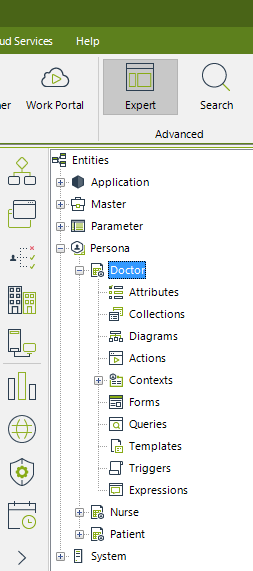
Each node displays the following information:

The Attributes node contains all the attributes of the entity filtered by data type. The data types considered as attributes are the common types (Boolean, currency, date time, file, string...) and one-to-one relationships with other entities. Each attribute has a name, a display name (which is the one used in the Work Portal) and its data type. When the data type is Entity, a Related entity is shown. Lastly, the Dpl column shows if the attribute is considered in deployment.
When the node is selected, the Ribbon will display the following options:

•Edit attributes: This option will display the Entity edition wizard in its second step. Allowing the user to modify, add or even delete attributes and relations, and their advanced properties.
•New relationship: This option will add the specified relationship between the entities selected. The entities does not have to be related with the current Persona.
•Refresh: This option will reload the information stored from the database, refreshing the attributes listed.

The Collections node contains all the one-to-multiple relationships of the entity. Each collection has a name, a display name (which is the one used in the Work Portal) and its related entity.
The Display in Me check allows the entity to be displayed in the My Stuff menu. To learn more, refer to the about the My Stuff menu documentation.
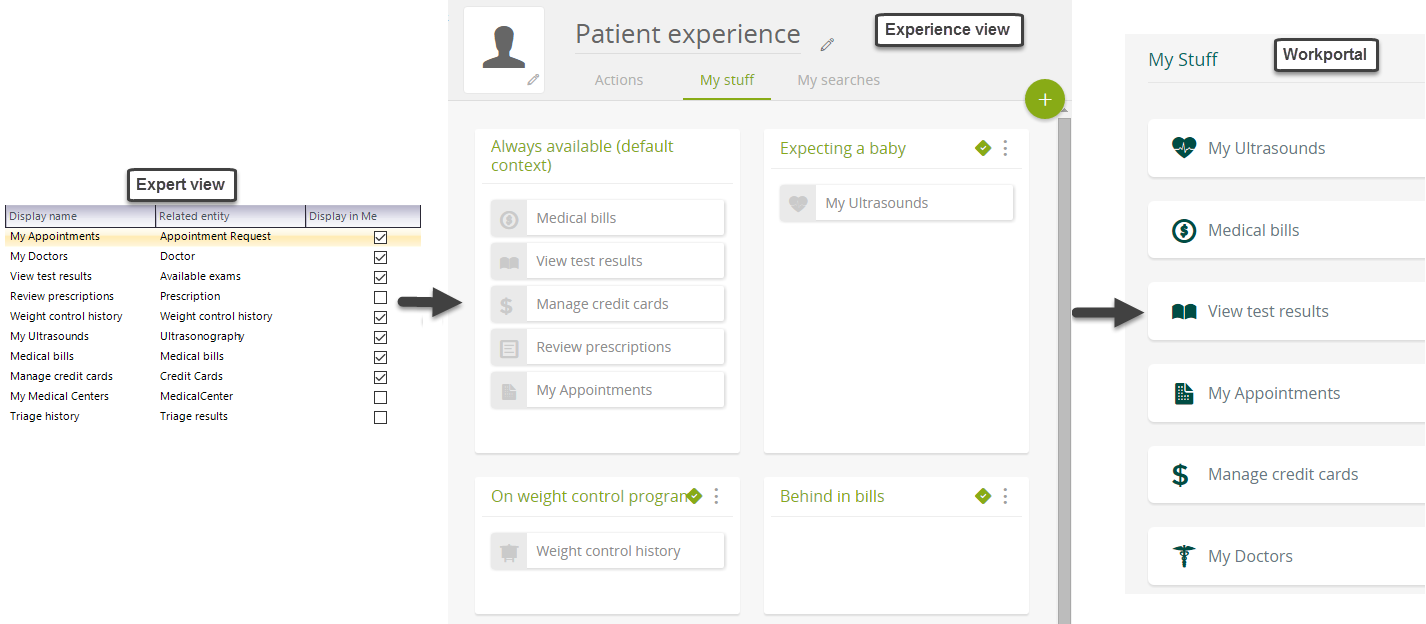
If a collection has been marked with the "Enable Add Button" option, then an option to add registries will be shown at the top of the results of a search or the values in Me Menu > My Stuff.

Any relationship can be attached to a context directly from the Master > Entities view, right-clicking the collection to attach:

When the node is selected, the Ribbon will display the following options:

•Edit attributes: This option will display the Entity edition wizard in its second step. Allowing the user to modify, add or even delete attributes and relations, and their advanced properties.
•New relationship: This option will add the specified relationship between the entities selected. The entities does not have to be related with the current entity.
•New indirect collection: this option will create an indirect relationship for the current entity. Indirect relationships are Xpaths which are not directly navigable but the entity is somewhat related to the current entity. When selected, a wizard will help to connect the current entity with the target entity. Bear in mind that every collection used through the indirect XPath can be filtered. The relationships shown at the right frame are the available relationships to navigate from the last entity added to the new indirect path.

Once the relation has been specified, the new relationship will be shown amongst the other relations. Please note that the icon of the indirect relationship is different to the other relationships.

•Refresh: This option will reload the information stored from the database, refreshing the collections listed.

The Diagrams node contains all the diagrams modeled for this entity. There is no limitation on how many diagrams can be created under a node.
The diagram does not have to have the entity from which the node is child of. nonetheless, it is highly advisable to include the entity since will help with the approach of your project.
The intention for these diagrams is to ease the data modeling for each entity and its relationships, since the Experience design needs more focus on each entity than in the process entity. Each diagram
has an Id, a name and a display name.
When the node is selected, the Ribbon will display the following options:

•New Diagram: This option will add a new blank diagram to the entity.
•Refresh: This option will reload the information stored from the database, refreshing the diagrams listed.

The Actions node contains all the Actions defined for this entity. Hence, these actions can be executed selecting the entity in My Stuff section of the Me Menu, or executed from a Process.
Every Action listed has a Display name, its operation (Form or Process), where can it be launched (whether Me menu or All Processes), the entity from which the current entity inherits from (if any), and if the Action is enabled. In case the Action is unchecked, the action will not be available for any Persona. If the Action had been previously configured, the Draft icon is gray, otherwise is black.
The Dply column shows if the Action has been launched to production (database icon) o if it is still in development (gear icon).
|
Bear in mind that any action created is by default unlinked to any context. Therefore the action must be manually linked to its correspondent contexts |
Any action can be linked to a context directly from the Master > Entities view, right-clicking the collection to attach:

When the node is selected, the Ribbon will display the following options:

•New Action: This option will start the Actions Advanced Configuration (Visit the Advanced Configurations documentation for more information) menu to add a new Action for the current entity.
•Refresh: This option will reload the information stored from the database, refreshing the Actions listed.

Every context designed for the Persona will be listed as a children of the Contexts node of said Persona. Bear in mind that the node Always available is added by default by Bizagi. When selected or right clicked, the node will display the following options:

•New context: This option allows the user to create a new context for the current Persona. When selected, the new Context window will be displayed.
•Refresh: This option will reload the information stored from the database, refreshing the Contexts listed.
Each Context presents the following nodes:

•Actions: All actions defined for a context are listed in this node, regardless what the action does (whether start a process, open a form nor execute a rule).

When selected or right clicked, the Actions node present the following options:
oNew Action: Allows the creation of a new Action directly related to the current Context.
oRefresh: This option will reload the information stored from the database, refreshing the Actions listed.
Every Action listed is displayed with its Display name and its deployment state. When an Action from the list is right-clicked, the following options are shown:

•Edit action: Starts the Advanced Actions Configuration menu with the information regarding the Action right-clicked.
•Delete action: Deletes the Action right-clicked.
•Copy to: Copies the action to be available in other Context of the same Persona.
•Move to: Move the action to be available in other Context of the same Persona, making it unavailable in the current Context.
•View dependencies: List all the elements in Bizagi Studio which use the Action, in a hierarchy.
When double-clicked, the Action starts the Advanced Actions Configuration menu with the information regarding the Action.
•Suggested: All suggestions for the Persona shown in the Relevant to me menu of the Work Portal are configured here.

When selected or right clicked, the Suggested node present the following options:
oNew Suggested: Allows the creation of a new suggestion directly related to the current Context. This suggestion will be shown in the Relevant to me menu of the Persona.
oRefresh: This option will reload the information stored from the database, refreshing the suggestions listed.
Every suggestion listed is displayed with its Display name, the classification it has, the process attached to it. Since the suggestions are designed to start Processes, every suggestion has a Process attached to it and they can be grouped by a classification, only one classification can be chosen for each suggestion.
When an Action from the list is right-clicked, the following options are shown:

•Edit suggested: Edit the current Suggested item. It opens the Suggested processes configuration window.
•Delete: Deletes the current Suggested item.
When double-clicked, the Suggested processes configuration window is started.
•Searches: All defined searches for a Persona in the Work Portal, regarding a context, can be configured through this node..

When selected or right clicked, the Suggested node present the following options:
oNew Search: Allows the creation of a new search directly related to the current Context. This search will be shown in the search field of the Work Portal in the Personas' session.
oRefresh: This option will reload the information stored from the database, refreshing the searches listed.
Every search listed is displayed with its Name, the entity to perform the search over, the form used to filter the search, and if the search is enabled to be used.
When a Search from the list is right-clicked, the following options are shown:

•Edit search: Edit the current Search. It opens the Search configuration window.
•Delete search: Deletes the current Search item.
•Copy to: Copies the Search to be available in other Contexts of the same Persona.
•Move to: Move the Search to be available in other Contexts of the same Persona, making it unavailable in the current Context.
•View dependencies: Displays in a hierarchy where is the Search being used.
When double-clicked, the Search configuration window is started.
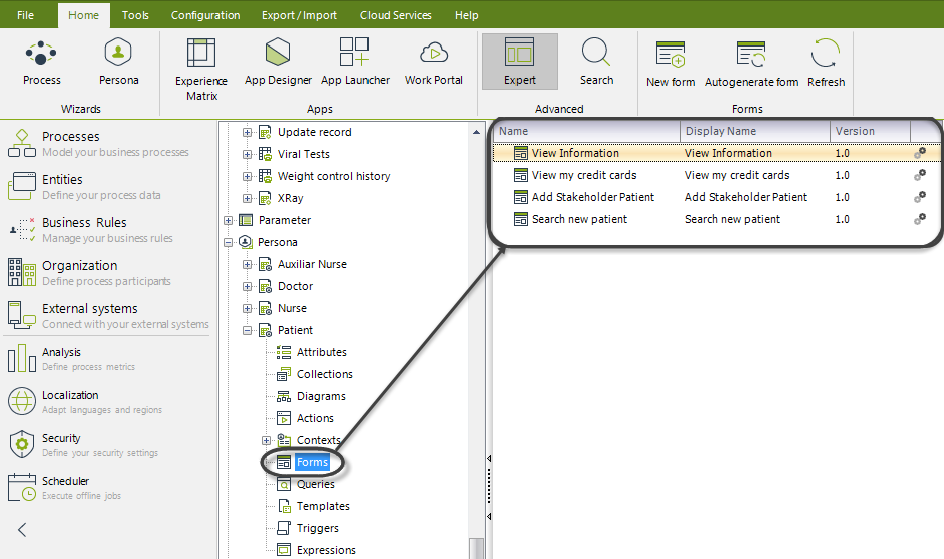
The Forms node contains all the Forms defined for this entity. These forms are used in the Work Portal to interact with the final users.
Every Form listed has a Name, a Display Name and version. The Dply column shows if the Form has been launched to production (database icon) o if it is still in development (gear icon).
When the node is selected, the Ribbon will display the following options:

•New Form: This option will start the Forms Editor (For more information, refer to the Define forms documentation) window to add a new Form.
•Autogenerate form: This option will automatically create a Form with all the current Persona information.
•Refresh: This option will reload the information stored from the database, refreshing the Forms listed.
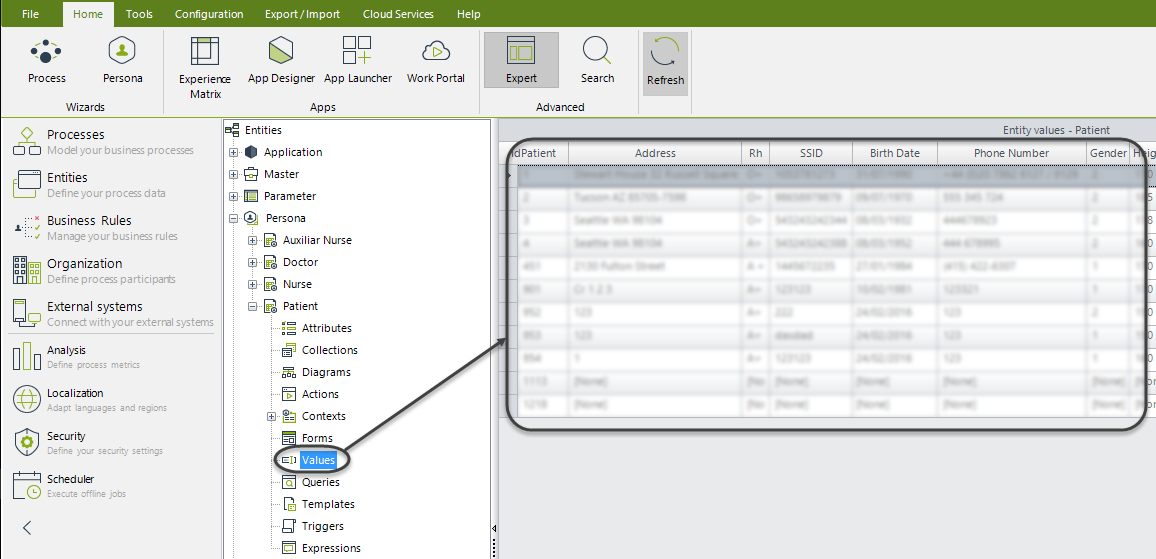
The Values node contains all the Persona values stored in the database.
Each value listed has its Primary Key and a column for each attribute or collection defined for the Persona. When the column is a collection, the value displayed will be the foreign key of the value.
When the node is selected, the ribbon displays the following:

•Refresh: This option will reload the information stored in the database, refreshing the values displayed.
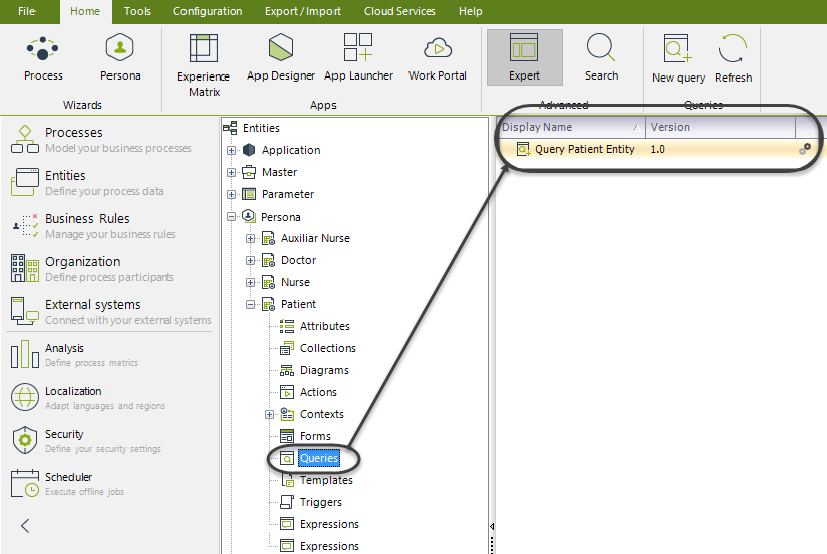
The Queries node contains all the queries defined for this entity. These queries are called Entity Query Forms they are used in the Work Portal to interact with the final users. To learn more, please refer to the Entity Query Forms documentation.
Every query listed has a Display Name and its version. The Display name column shows if the query has been launched to production (database icon) o if it is still in development (gear icon).
When the node is selected, the Ribbon will display the following options:

•New query: This option will start the Forms Editor (For more information, refer to the Creating user interface documentation) window to add a Query Form.
•Refresh: This option will reload the information stored from the database, refreshing the queries listed.

The Templates node, contains all the templates defined for this entity. These templates are used in the Work Portal to interact with the final users. To learn more, please refer to the Data Templates documentation.
Every template listed has a display name, its defined type, to which Persona does it applies for and where is the template able to be shown. The Enabled check, allows the template to be displayed. The Display Name column shows if the template has been launched to production (database icon) o if it is still in development (gear icon).
When the node is selected, the Ribbon will display the following options:

•New template: This option will start the Template Configuration window (For more information, refer to the Studio Data Template documentation) to add a Data Template.
•Refresh: This option will reload the information stored from the database, refreshing the templates listed.
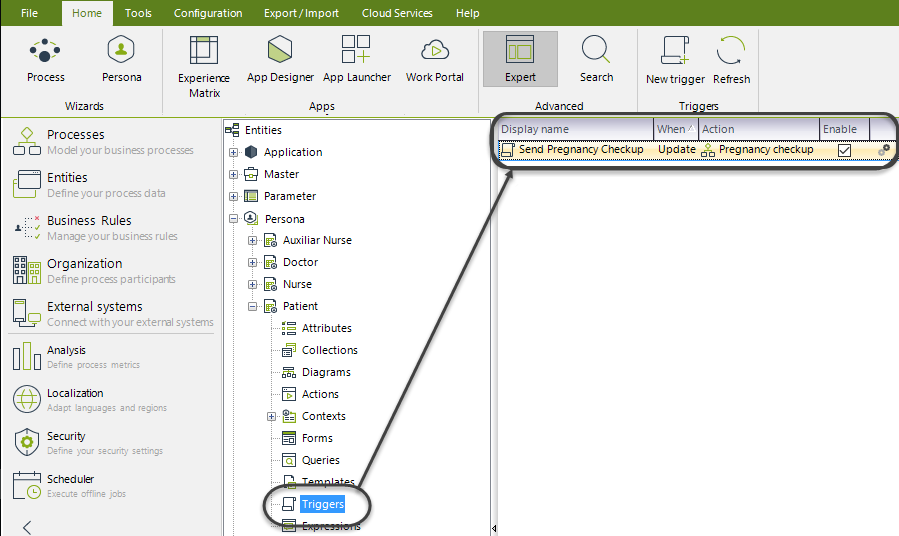
The Triggers node contains all the triggers defined for this entity. These triggers are data based actions. To learn more, please refer to the Triggers documentation.
Every trigger listed has a display name, when will the trigger be launched, and the action to execute. The Enabled check allows the trigger to be used. The Display Name column shows if the trigger has been launched to production (database icon) o if it is still in development (gear icon).
When the node is selected, the Ribbon will display the following options:

•New trigger: This option will start the Trigger Configuration window (To learn more, refer to the Studio Triggers documentation) to add a Trigger.
•Refresh: This option will reload the information stored from the database, refreshing the triggers listed.
If a trigger is right-clicked, the following options will be displayed:

•Edit trigger: This option starts the Trigger Configuration window, allowing the edition of the trigger.
•Delete trigger: This option deletes the trigger as long as any related dependencies are found.
•View dependencies: This option hierarchically lists all the dependencies of the trigger.

The Expressions node contains all the expressions defined for this entity. To learn more, please refer to the Expressions documentation.
Every expression listed has a name, and a display name. The Dply column shows if the expression has been launched to production (database icon) o if it is still in development (gear icon).
When the node is selected, the Ribbon will display the following options:

•New expression: This option will start the Expression Configuration window to add a Expression.
•Refresh: This option will reload the information stored from the database, refreshing the expressions listed.
If a expression is right-clicked, the following options will be displayed:

•Properties: This option starts the Expression Configuration window, allowing the edition of the expression.
•Delete Rule: This option deletes the expression as long as any related dependencies are found.
•View dependencies: This option hierarchically lists all the dependencies of the expression.
Last Updated 5/31/2024 11:30:37 AM